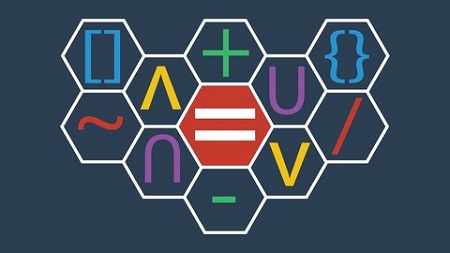
English | MP4 | AVC 1920×1080 | AAC 44KHz 2ch | 19 Hours | 3.40 GB
Master Discrete Math for Computer Science and Mathematics Students
Discrete Mathematics (DM), or Discrete Math is the backbone of Mathematics and Computer Science. DM is the study of topics that are discrete rather than continuous, for that, the course is a MUST for any Math or CS student. The topics that are covered in this course are the most essential ones, those that will touch every Math and Science student at some point in their education. The goal of this course is to build the mathematical foundation for computer science courses such as data structures, algorithms, relational and database theory, and for mathematics courses such as linear and abstract algebra, combinatorics, probability, logic and set theory, and number theory.
Discrete Mathematics gives students the ability to understand Math language and based on that, the course is divided into the following sections:
- Sets
- Logic
- Number Theory
- Proofs
- Functions
- Relations
- Graph Theory
- Statistics
- Combinatorics
- and Sequences and Series
I know visually seeing a problem getting solved is the easiest and the most direct way for a student to learn so I designed the course keeping this in mind. The materials are delivered through videos to make complex subjects easy to comprehend. More details on certain lessons are delivered through text files to provide more explanations or examples. The course is taught in plain English, away from cloudy, complicated mathematical jargon, to help the student learn the material rather than getting stuck on fancy words.
What you’ll learn
- You will learn and develop the ability to think, read and write abstractly and Mathematically.
- You will learn the fundamentals of Set Theory including set builder notation, and set operations and properties.
- You will learn tautologies, contradictions, De Morgan’s Laws in Logic, logical equivalence, and formulating quantified statements.
- You will lear how to create truth tables and tell the falsehood and truthfulness of a compound statements.
- You will know how to write, read and prove Mathematical statements using a variety of methods.
- You will understand boolean expressions, black boxes, logical gates and digital circuits.
- You will understand the Fundamental Theorem of Arithmetics, modular arithmetic, and learn how to find GCD & LCM.
- You will acquire a solid foundation in functions, function composition & combination, bijective and inverse functions.
- You will learn how to find equivalence relations and equivalence classes.
- You will learn essential concepts in Statistics and Combinatorics.
- You will master arithmetic and geometric sequences, and partial sums.
- You will learn the fundamental concepts in Graph Theory like incidence and adjacency matrices, walks, eccentricity, hamiltonian paths and circuits, connectedness, and Ore’s Theorem.
Table of Contents
Sets
1 Introduction
2 Definition of a Set
3 Number Sets
4 Set Equality
5 Set-Builder Notation
6 Types of Sets
7 Subsets
8 Power Set
9 Ordered Pairs
10 Cartesian Products
11 Cartesian Plane
12 Venn Diagrams
13 Set Operations (Union, Intersection)
14 Properties of Union and Intersection
15 Set Operations (Difference, Complement)
16 Properties of Difference and Complement
17 De Morgan’s Law
18 Partition of Sets
19 Extra Practice Problems
Logic
20 Introduction
21 Statements
22 Compound Statements
23 Truth Tables
24 Examples
25 Logical Equivalences
26 Tautologies and Contradictions
27 De Morgan’s Laws in Logic
28 Logical Equivalence Laws
29 Conditional Statements
30 Negation of Conditional Statements
31 Converse and Inverse
32 Biconditional Statements
33 Examples
34 Digital Logic Circuits
35 Black Boxes and Gates
36 Boolean Expressions
37 Truth Tables and Circuits
38 Equivalent Circuits
39 NAND and NOR Gates
40 Quantified Statements – ALL
41 Quantified Statements – THERE EXISTS
42 Negations of Quantified Statements
Number Theory
43 Introduction
44 Parity
45 Divisibility
46 Prime Numbers
47 Prime Factorization
48 GCD & LCM
Proofs
49 Intro
50 Terminologies
51 Direct Proofs
52 Proofs by Contrapositive
53 Proofs by Contradiction
54 Exhaustion Proofs
55 Existence & Uniqueness Proofs
56 Proofs by Induction
57 Examples
Functions
58 Intro
59 Functions
60 Evaluating a Function
61 Domains
62 Range
63 Graphs
64 Graphing Calculator
65 Extracting Info from a Graph
66 Domain & Range from a Graph
67 Function Composition
68 Function Combination
69 Even and Odd Functions
70 One to One (Injective) Functions
71 Onto (Surjective) Functions
72 Inverse Functions
73 Long Division
Relations
74 Intro
75 The Language of Relations
76 Relations on Sets
77 The Inverse of a Relation
78 Reflexivity, Symmetry and Transitivity
79 Examples
80 Properties of Equality & Less Than
81 Equivalence Relation
82 Equivalence Class
Graph Theory
83 Intro
84 Graphs
85 Subgraphs
86 Degree
87 Sum of Degrees of Vertices Theorem
88 Adjacency and Incidence
89 Adjacency Matrix
90 Incidence Matrix
91 Isomorphism
92 Walks, Trails, Paths, and Circuits
93 Examples
94 Eccentricity, Diameter, and Radius
95 Connectedness
96 Euler Trails and Circuits
97 Fleury’s Algorithm
98 Hamiltonian Paths and Circuits
99 Ore’s Theorem
100 The Shortest Path Problem
Statistics
101 Intro
102 Terminologies
103 Mean
104 Median
105 Mode
106 Range
107 Outlier
108 Variance
109 Standard Deviation
Combinatorics
110 Intro
111 Factorials
112 The Fundamental Counting Principle
113 Permutations
114 Combinations
115 Pigeonhole Principle
116 Pascal’s Triangle
Sequence and Series
117 Intro
118 Sequence
119 Arithmetic Sequences
120 Geometric Sequences
121 Partial Sums of Arithmetic Sequences
122 Partial Sums of Geometric Sequences
123 Series
124 Bonus Lecture
Resolve the captcha to access the links!